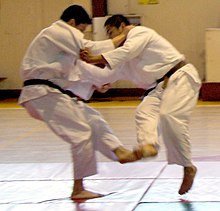Sweep (grappling)
| Sweep | |||||||

Using one's leg to sweep an opponent is an important element of many martial arts throws, such as this foot sweep (deashi harai).
|
|||||||
| Japanese name | |||||||
|---|---|---|---|---|---|---|---|
| Kanji | 足払い | ||||||
| Hiragana | あしばらい | ||||||
|
|||||||
| Transcriptions | |
|---|---|
| Revised Hepburn | ashi-barai |
| Kunrei-shiki | asi-barai |
A sweep is the name used for two categories of martial arts techniques. From standing, sweeps are throws or takedowns that primarily use the legs to attack an opponent's legs. On the ground, sweeps are techniques for reversing a grappling position.
When standing it is a technique used to take an opponent to the ground by knocking their legs out from under them, so is classed as a throw or takedown The force of the sweep either runs perpendicular to the opponent's leg or rises as it strikes the leg, lifting the foot from the ground. A sweep can be used to take the opponent to the ground or it can simply disrupt the opponent's balance long enough to make an opening for a punch or kick. In Japanese it is known as ashi-barai.
'Spoon-type' Sweep
Using a hook kick
Using a spinning kick
A sweep, when referred to in the context of ground fighting is a technique used to transition from a neutral or inferior position to a dominant position, such as a practitioner moving from in an opponent's guard to full mount, hence the alternative term 'reversal' as the dominance of positions have been reversed.
A Push sweep is one of the guard sweeps described in Brazilian Jiu-Jitsu, Theory and Technique by Renzo and Royler Gracie. It is also demonstrated in The Essence Of Judo by one of Kyuzo Mifune's students, and it is an unnamed technique described in The Canon Of Judo. The main characteristic of the Push sweep is the practitioner pushing the opponent's knee out from under them with their foot, when the practitioner has the opponent in their open guard.
...
Wikipedia
